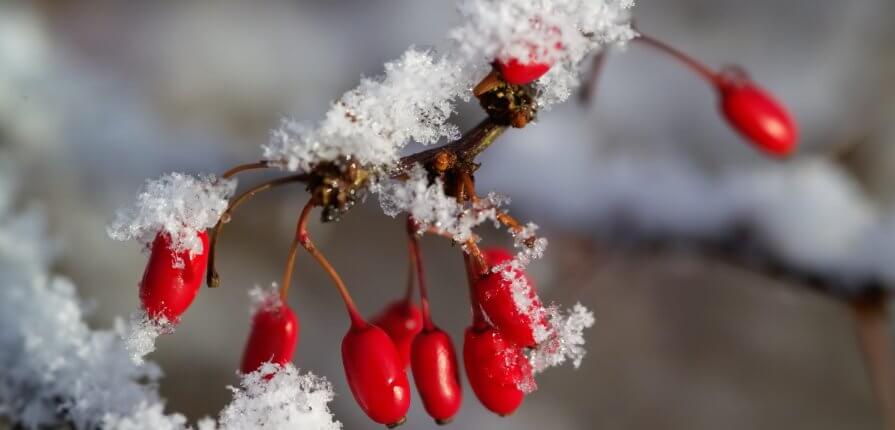February is the month of romance and the final month of winter in the UK. February is a month to draw to an end to the dark months and begin planning for the brighter spring days. Getting out in your garden can be a great way to finish growing jobs and prepare for the month ahead despite the bitter temperatures and frosty conditions. There are a variety of gardening jobs that can be completed in February to get it ready for the Spring and to prolong the shoots from winter.
Before starting the February jobs you must be up to date with all of the January gardening jobs that need to be completed. Staying up-to-date and on top of your gardening jobs is essential for a healthy and successful garden.
1 – Protect Blossom On Apricots, Nectarines, And Peaches
In Britain, the softest fruit and top fruit trees are very resilient even while dormant over the winter as temperatures don’t fall low enough to harm them. Those living in extreme climates, such as the north of Scotland or high in the hills, may need to choose cold-resistant rootstocks and cultivars.
Frost, however, can easily damage the new growth and blossoms in late winter and early spring. If severe frosts threaten, protection should be maintained for two weeks after flowering not only for plants in full bloom but also for buds and even fertilised flowers.
A frost can form when the temperature drops below 0oC (32oF). Heat is lost when it radiates out on a clear night. Due to its heavier weight than warm air, cold air forms on trees and other objects, dislodging warm air. As a result, objects near the ground such as vegetable patches and shrub-growing fruits become chilled and freeze. Flowing air naturally collects at the lowest point or against a barrier on sloping ground. To improve air drainage, consider removing some lower growth on a fence or hedge to create a gap. Place the larger more sturdy fruit trees at the bottom, and the smaller ones at the top if there is no other alternative.
2 – Prune Winter Flowering Shrubs That Have Finished Flowering
To encourage strong, healthy shoots and improve flowering, deciduous shrubs that flower in late winter, spring, and early summer require annual pruning. Pruning these early-flowering shrubs annually also prolongs their lives.
Depending on the shrub, early-flowering shrubs are pruned after flowering (in late winter to spring and early summer). They usually bloom on the growth of the previous year. When you prune straight after flowering, your plants have the maximum amount of time to develop young growth before the end of the summer to provide flowers for the following year.
It depends on the type of shrub, but all early-flowering shrubs require routine removal of damaged, diseased, or dead wood. If there are any damaged or dead shoots, cut them back to their point of origin or to the ground. Once that is done, remove some of the stems to the ground level to keep the bush open and prevent congestion. Last but not least, trim back any weak, spindly or twiggy shoots to the ground so that the plant can concentrate on strong new shoots that will yield the best flowers.
3 – Kill Perennial Weeds In Your Garden And Beds
Often these can be forked out, removing all the roots, and burnt or put out with the rubbish. In addition, you can use a weed-suppressing mulch or membrane to control the growth of weeds. Systemic weedkillers like glyphosate can also be used to kill weeds since it is applied to the foliage and absorbed into the sap of the plant.
Hoeing and mulching can control most annual weeds, but perennials tend to grow fast and strong, so a little more effort is required to eradicate them. Wildflowers like spear thistle, valerian, and celandines, as well as ornamental plants like curled tansy, and grasses, are perennial weeds. As some weeds thrive in particular soil types or circumstances, it’s impossible to predict what will be a problem.
The root type of perennial weeds can be used to identify and treat them accordingly. If you know what you’re dealing with, whether it’s deep tap roots or short, spreading weeds, you’ll be able to take effective action. Not weeding can be one of the biggest mistakes in the garden so it’s best to do this when they first appear.
4 – Prepare Seed Beds For Vegetables
It is common for people to view a seedbed as an unimportant part of a garden. It is important to remember that seed germination and early growth of plants have a significant influence on their final quality. For example, if hedges or buildings shade the seedbed, seedlings may be weak and spindly. Seeds usually don’t do well if they become waterlogged (or if they dry out), so drainage is paramount.
Seed beds are similar to vegetable beds, except that the soil must only be forked to a shallow depth. It will be necessary to dig and prepare a new bed if it has never been used to grow plants before.
It will require less preparation if plants have already been grown on the bed as most stones will have been removed and the soil is broken up.
While vegetable beds are usually thought of as autumn jobs, preparing your vegetable at the end of winter will allow for longer, healthier growths. Preparing seed beds allows for seeds to be brought on before being moved to their final position later in the season for full growth.
5 – Protect Fruits And Vegetables From Birds By Netting Them
February sees birds beginning to appear in the garden as well as many other wildlife species that may have been in hibernation. The most likely bird in a garden throughout the year and often the most unliked is the typical grey pigeon. Pigeons can rip leaves apart, leaving just the stalks and larger veins behind. There are many plants that pigeons feed on, but lilacs, brassicas, and peas are their favourites.
Using bird nets for fruit trees is one of the best ways to prevent birds from eating your fruits and vegetables. Bird droppings can also spread diseases to your plants, causing a lot of damage to your crop in a short period of time.
Crops are protected from birds with butterfly netting, while bees and butterflies can pollinate them later in the spring and summer seasons. Keep your netting pulled taught, and use netting with holes smaller than one centimetre to avoid injury to birds.
6 – Continue To Feed The Birds
Although you may not want birds feeding on your fruit and vegetables, February and other winter months are vital for feeding birds in the garden with high-fat alternatives. As there is less wildlife and insects available for them to feed on, providing them with extra food helps them to build up their fat supplies for the cold nights.
Different birds have different tastes and favourite foods, so feeding the birds who already frequent your garden is a good start, plus it will encourage them to return. Using different types of feed will allow you to attract a wider range of birds into your garden once you have fed your regular visitors.
Sunflower seeds, niger seeds, peanuts, mealworms, and suet balls are some of the best food choices for birds in the winter and can either be bought from your nearest garden centre or can be created at home. Throughout the colder months, continue to put out food regularly. It may even be necessary to put out food twice a day, once in the morning and again in the afternoon if the weather is particularly severe.
7 – Plant Containers With Robust Spring Bedding
Seasonal and permanent plants can be used in containers throughout the year, even during the coldest months. A garden corner can be brightened up with them, a kitchen counter can be provided with handy herbs, or an entrance can be made to look welcoming. You must choose the right compost and perform regular maintenance to ensure plants thrive in containers.
Pots made of clay or terracotta are prone to cracking in frost, so either avoid using them for winter displays or use frostproof pots. All types of plastics, fibreglass, and wooden pots, as well as treated terracotta and clay, are good materials for winter pots. Pots labelled frost-proof are more likely to hold up to freezing temperatures than frost-resistant ones. Potting your spring bedding in robust pots will help them last throughout the cold February climate and save you from having to re-pot later into the spring.
8 – Fertilize flowering shrubs and roses with slow-release fertilizer
February is the ideal time to prepare your flowering shrubs for spring growth. The rose needs a continuous supply of nutrients throughout the growing season in order to perform at its best. Not only do healthy roses bloom better, but they are also more resistant to disease and insects. Keeping a gardening calendar handy where you can write down when and how you fertilise will help you stay organised.
Roses usually awaken from their winter slumber in late March or early April and should be fertilised when the first buds start to sprout at the latest. Fertilizing them with a slow-release fertiliser in February allows for early growth and protection before the first growth appears. In late June or early July, second fertilization is recommended for repeat-flowering rose varieties.
9 – Prepare For The Summer By Installing Water Butts.
A great time to collect rainwater to use in your garden is in February. It is environmentally friendly to use a water butt because it reuses naturally occurring water rather than drawing on the supply, but it also offers other benefits such as saving you money and benefitting the plants in your garden.
It is best to maintain water butts in February or March. Water butts usually have a sump drawdown point and a top access point. You can open the tank and let the bottom draw down, then pop a hose into the top, swill the water around, and allow the accumulated sediment to drain. You can keep the water fresh by removing leaves and organic matter from the tank using a filter or leaf catcher as described above and by adding an antimicrobial disc.
10 – Be Sure That Your Tools And Garden Machinery Are In Working Order
February is an ideal time to check your gardening tools and prepare for spring
During the cooler months, you may spend more time indoors than outside this summer, so what better time than now to make sure your tools are in good condition? To ensure you’re fully equipped, have a shed or garage full of the tools you need. It’s an important part of maintaining your garden.
Garden tools should be wiped down each time you use them, but in the real world, time is often not on your side. Washing off any dirt with soapy water every now and then helps to spruce them up and even get rid of pests and diseases. To remove dirt, use a brush if necessary.
Whether you are pruning, mowing, or sawing, blunt blades will eventually make your job much harder and might even cause issues with plants. It is recommended that you replace any that are damaged, but if not, you can use some oil on the blade and then file the edges to sharpen them. Shears, secateurs, and hoes can all be cleaned in this way. Wipe away any residual oil after you have sharpened the tools.









— 10,388 Comments —